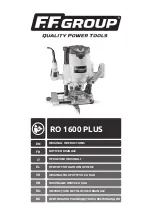
14
| English
Only use undamaged and clean router bits.
Fitting the routing base (see figure A)
To start routing, the routing base
(2)
must be fitted back
onto the drive unit
(1)
.
Open the wing bolt
(10)
on the routing base
(2)
.
Slide the drive unit
(1)
into the routing base
(2)
.
Close the wing bolt
(10)
on the routing base
(2)
.
u
After assembly, always check that the drive unit is
firmly seated in the routing base.
Dust/Chip Extraction
Dust from materials such as lead-containing coatings, some
wood types, minerals and metal can be harmful to one’s
health. Touching or breathing-in the dust can cause allergic
reactions and/or lead to respiratory infections of the user or
bystanders.
Certain dust, such as oak or beech dust, is considered carci-
nogenic, especially in connection with wood-treatment ad-
ditives (chromate, wood preservative). Materials containing
asbestos may only be worked by specialists.
– Provide for good ventilation of the working place.
– It is recommended to wear a P2 filter-class respirator.
Observe the relevant regulations in your country for the ma-
terials to be worked.
u
Avoid dust accumulation at the workplace.
Dust can
easily ignite.
Operation
u
Products that are only sold in AUS and NZ:
Use a resid-
ual current device (RCD) with a nominal residual current
of 30 mA or less.
u
Pay attention to the mains voltage. The voltage of the
power source must match the voltage specified on the
rating plate of the power tool. Power tools marked
with 230 V can also be operated with 220 V.
Setting the routing depth
u
The routing depth must only be set while the power
tool is switched off.
To set the rough routing depth, proceed as follows:
– Place the power tool with a fitted router bit onto the work-
piece you want to machine.
– Open the wing bolt
(10)
on the routing base
(2)
.
– Move the drive unit
(1)
to the required depth using the
scale for setting the routing depth
(12)
as a guide.
– Close the wing bolt
(10)
on the routing base
(2)
.
– Check the routing depth you have set by carrying out a
practical test and correct it if required.
Starting Operation
Switching on/off
To
switch on
the power tool, set the on/off switch
(11)
to
I
.
To
switch off
the power tool, set the on/off switch
(11)
to
0
.
Working Advice
u
Protect router bits against shock and impact.
u
Pull the plug out of the socket before carrying out any
work on the power tool.
Routing direction and routing process (see figure D)
u
Routing must always be carried out with the work-
piece being moved against the direction in which the
router bit
(6) is turning (up cut).
If the workpiece is
moved in the same direction as the router bit is turning
(down cut), the power tool may be pulled out of your
hands.
u
Only use the power tool when the routing base
(2) is
fitted.
Losing control of the power tool can cause injur-
ies.
Note:
Be aware that the router bit
(6)
always protrudes
slightly from the base plate
(9)
. Do not damage the template
or the workpiece.
Set the routing depth you want.
Switch on the power tool and guide it to the point you want
to machine.
Switch off the power tool after routing.
u
Do not put the power tool down before the router bit
has come to a complete stop.
Application tools that are
still running can cause injuries.
Routing with guide bushing (see figure E1 – E3)
Using the guide bushing
(17)
, you can transfer contours
from templates or patterns to the workpiece.
Select the guide bushing that is suitable for the thickness of
the template or pattern. Due to the protruding height of the
guide bushing, the template must have a minimum thickness
of 8 mm (see figure
E1
).
u
Select a router bit with a diameter that is smaller than
the interior diameter of the guide bushing.
Unscrew the four cylinder screws on the underside of the
guide plate
(8)
and remove the guide plate.
Insert the guide bushing
(17)
into the guide plate (see fig-
ure
E2
).
Loosely screw the guide plate back onto the base plate
(9)
.
It must still be possible to move the guide plate freely.
To ensure that the distance between the centre of the router
bit and the edge of the guide bushing is uniform, the guide
bushing and guide plate must (if necessary) be centrally
aligned with each other.
– Align the guide plate such that the router bit and guide
bushing are centred on the opening in the guide plate
(see figure
E3
).
– Hold the guide plate in this position and firmly tighten the
fastening screw.
To rout with the guide bushing
(17)
, proceed as follows:
– Place the power tool with the guide bushing
(17)
onto the
template.
– Guide the power tool with the protruding guide bushing
along the template using lateral pressure.
1 609 92A 5B0 | (01.10.2019)
Bosch Power Tools















































